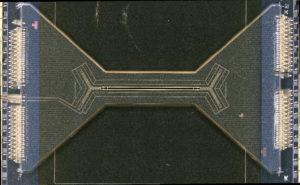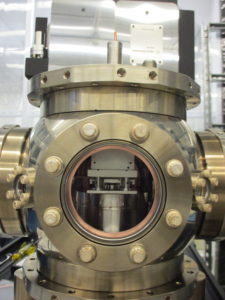A quantum bridge

An ion trap designed and fabricated at Sandia National Laboratories. This trap features two junctions and a long linear region with a slot. (Photo: Sandia.)
Note: Sandia National Laboratories is presenting a workshop on quantum computing software this month at SC20, the international supercomputing conference.
Two Sandia National Laboratories software teams face big challenges in the quest to make quantum computers – ones relying on the strange rules governing the sub-microscopic world – that are as reliable and controllable as the ubiquitous devices of our classical-computing world.
“It’s one of the deep mysteries of the past century that the whole universe is quantum mechanical,” says Robin Blume-Kohout, who leads Sandia’s Quantum Performance Laboratory.
“But we and everything we touch and see obeys these classical rules that are much more limiting,” he says. The “quantum rules are fragile” so “quantum computing is about finding a very protected place” – a kind of software glove box through which we can access their world only indirectly.
Mohan Sarovar, who heads another Sandia-based project called Optimization, Verification and Engineered Reliability of Quantum Computers, says the field’s goal is a universal quantum computer that operates as reliably “as the laptop I have now. We know that will require a lot more development.” Sarovar estimates that an error-resistant quantum computer is “probably decades away at least.”
Given the successes of normal devices, why even try?
Classical computers’ integrated circuit dimensions have dramatically shrunk over the years, becoming consistently more powerful in the process. The building blocks, based on complementary metal oxide semiconductors, have, in turn, remained error resistant during this evolution, Sarovar notes.
Today’s everyday machines harbor billions of microscopic transistors that act as switches. Those create hordes of calculating bits representing either a 0 or a 1, depending on whether a transistor was off or on when activated. Within each microprocessor, potentially millions of electronic circuits called logic gates then determine which calculations, guided by codes, to perform.
Despite classical computing’s stellar track record, such giants as IBM and Intel have joined newcomers to dabble in quantum computing. The potential payoff is enormous.
Residents of the quantum world, such as electrons and photons, are permitted to behave weirdly. They can, for instance, act as waves as well as particles. They also can seemingly be in different places at the same time. If computing bits behaved like that, the 0s and 1s in a calculation could be joined by mixtures of both. They could also simultaneously represent all conceivable alternatives. They could even lock themselves into entangled interactions in which one partner’s value instantly reveals the other’s, even when widely separated.

An ion trap mounted in a high vacuum chamber built at Sandia National Laboratories, visible through one of the chamber’s windows. (Photo: Sandia.)
Such strange properties would, theoretically, allow quantum computers to vastly outperform classical ones. But there’s a big hitch: To avoid violating well-established mathematical principles, exotic behaviors must be confined to the quantum world. Manufacturers must create special hardware that can operate in quantum environments. The most popular designs tap either superconducting circuits or laser-trapped ions. Such ensembles switch and manipulate quantum-bit equivalents called qubits to perform what Sandia’s Blume-Kohout describes as “free and uninhibited” quantum calculations using special versions of logic gates.
But information must remain isolated from the classical world “because if we touched it, we would destroy it,” he says. Programmers must communicate indirectly with quantum computers by “sending in classical messages and getting back classical answers, never having touched the quantum part of it.”
The classical program tells the quantum computer how to encode instructions into temporary memory registers for quantum manipulations. During output, the quantum computer is shut off and opened to learn how the program has been altered. “At the end of the computation,” Blume-Kohout says, “the quantum computer’s operator reads off its result by sending in electronic pulses that reveal what bits were encoded in the memory registers after all those manipulations.”
Unfortunately, hardware imperfections lead to noise and errors in the final answers, especially when the quantum computers work via logic gates. “We’ve known for 25 years that those errors were going to be absolutely an obstacle.”
Sandia is addressing such problems with $42 million in support from the Department of Energy’s Advanced Scientific Computing Research (ASCR) program.
With its current grant of $3.7 million over five years, Blume-Kohout’s team has focused on “detecting, quantifying and measuring these errors and providing debugging information to hardware designers,” he says. The group will “test and assess the performance of quantum computers and components by asking these devices to do their jobs.”
To help out, researchers have created numerous software programs called test suites to rate how well devices process small numbers of qubits. Those programs are run within special diagnostic testbed quantum computers that industrial and academic researchers rely on.
Sandia recently finished building its own Quantum Scientific Computing Open User Testbed (QSCOUT) using trapped ions. That project will receive $25.1 million in ASCR support over five years. Blume-Kohout says his team is excited about techniques they recently developed that “can tell anybody at a glance what programs you could reasonably expect such a testbed to be able to run.”
Sarovar leads a team at Sandia plus Los Alamos National Laboratory, Dartmouth College and the University of New Mexico that is receiving $7.8 million in ASCR support over four years. He likens his group’s challenges to those high-energy physicists face in interpreting data from colliding subatomic particles. The results will be “noisy,” he says – imperfect.
“Given that we know about this noise in a device, how do we rewrite a quantum program in a way that is least sensitive to that noise?” he asks. He says his group is working to develop middleware – “a connecting glue of classical software that will try to make sense out of the noisy data.”
That middleware will treat any near-term quantum computer as a kind of co-processor, operating akin to how today’s graphic processing units accelerate certain calculations in modern classical computer architectures.
“Developing error correction and fault tolerance will require a lot of qubits and very high-quality gates,” Sarovar says. “And the machines we have currently and will probably have for the near future won’t meet these requirements.”
Blume-Kohout agrees. “The whole field of quantum computing can succeed only if both hardware and algorithms improve dramatically. We are counting on it.”
About the Author
Monte Basgall is a freelance writer and former reporter for the Richmond Times-Dispatch, Miami Herald and Raleigh News & Observer. For 17 years he covered the basic sciences, engineering and environmental sciences at Duke University.




